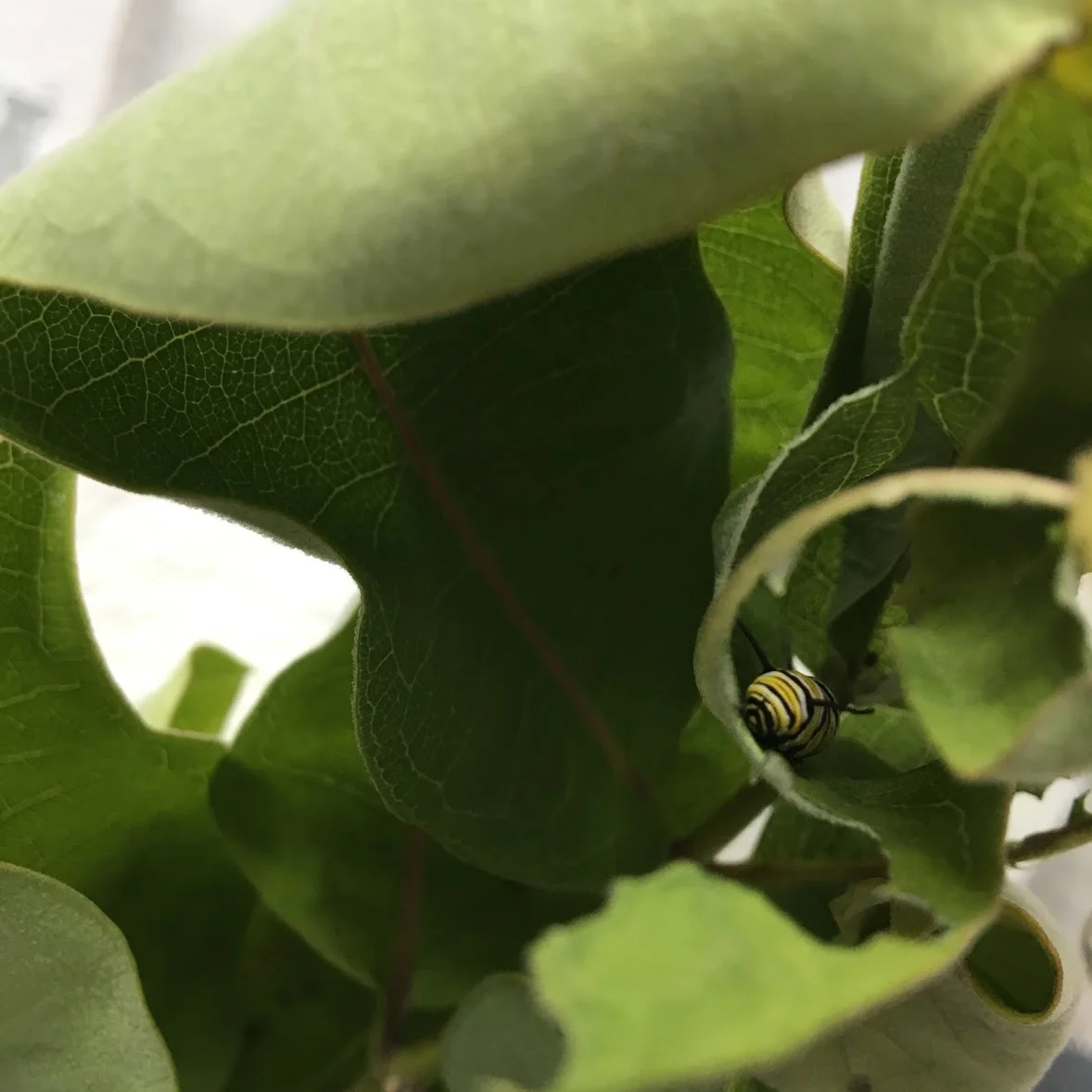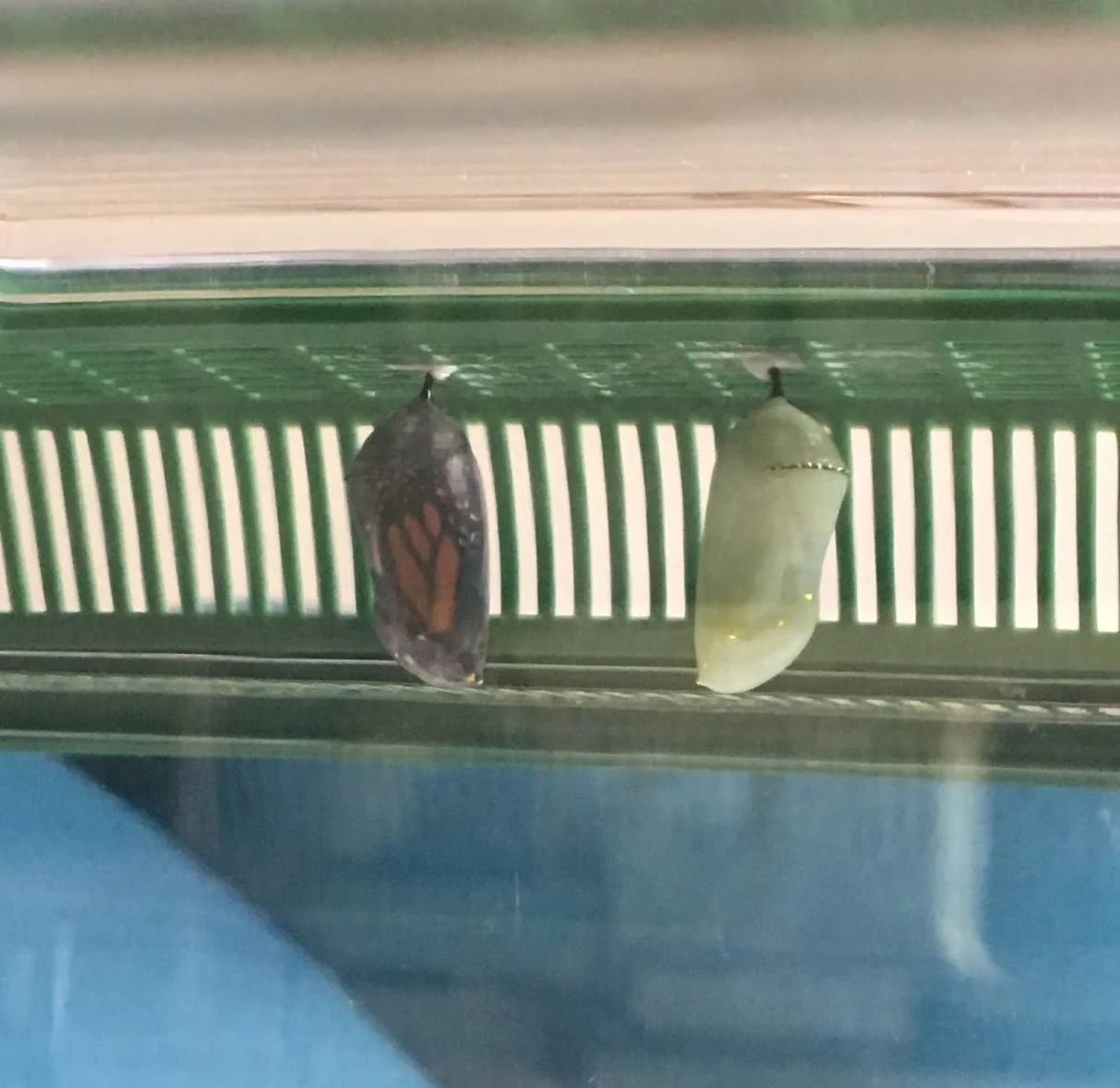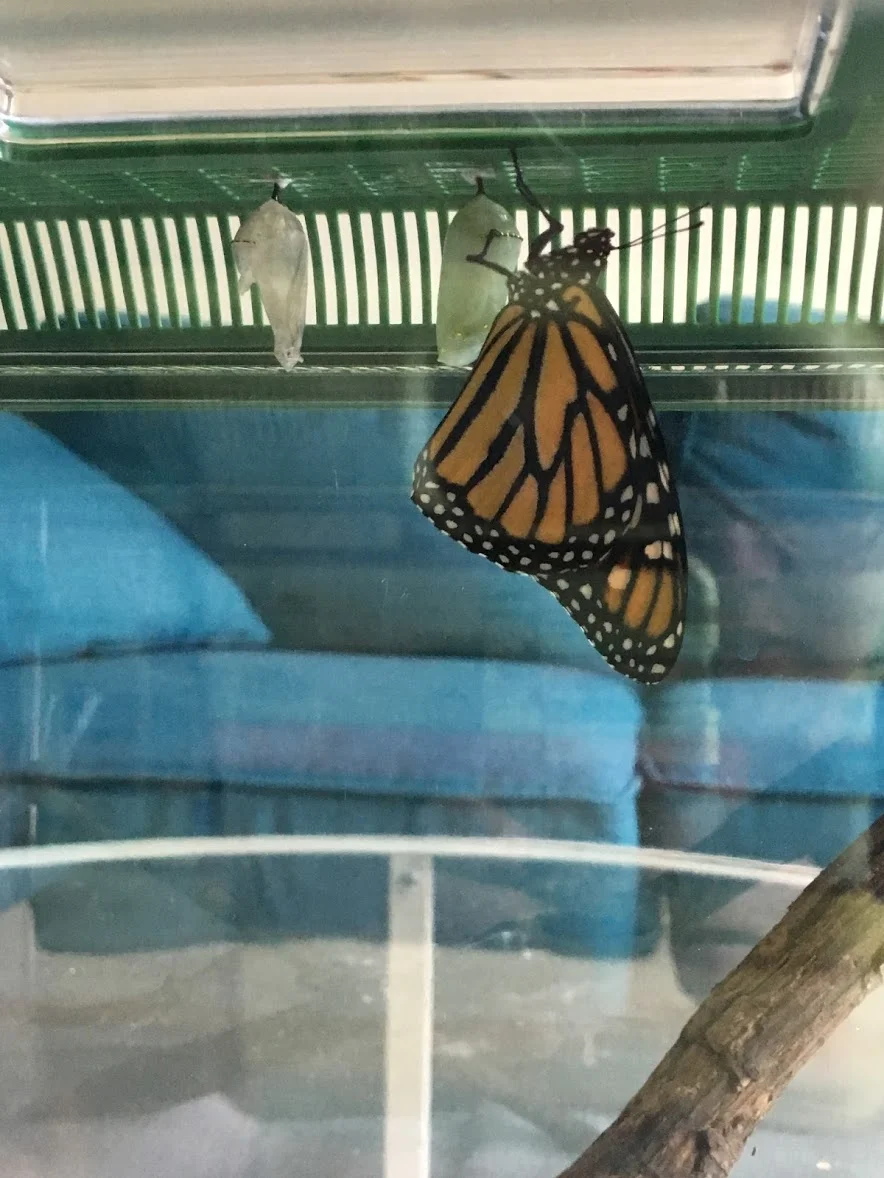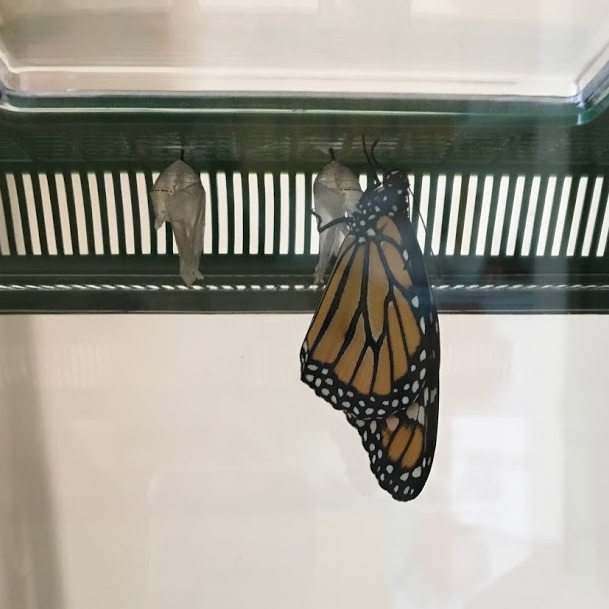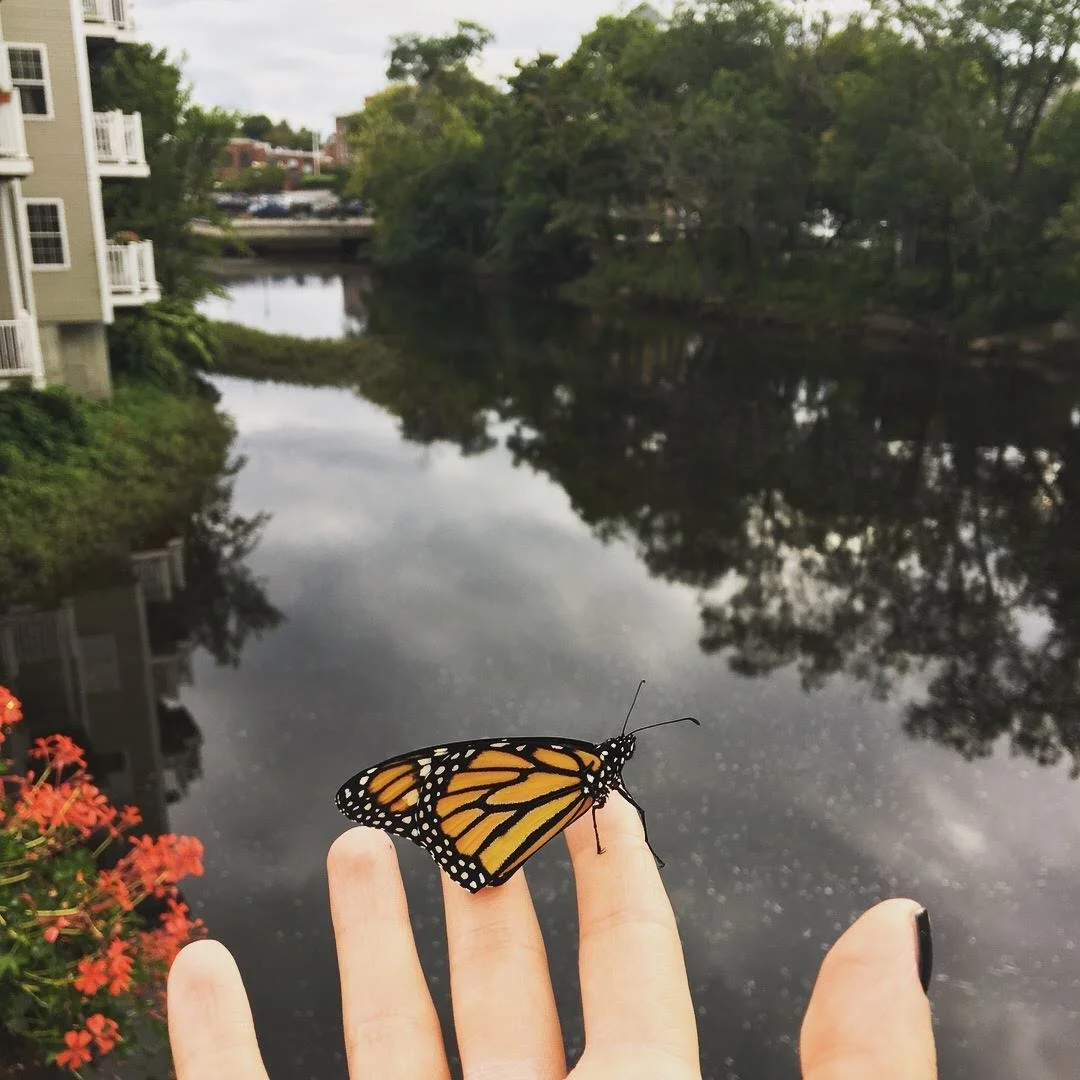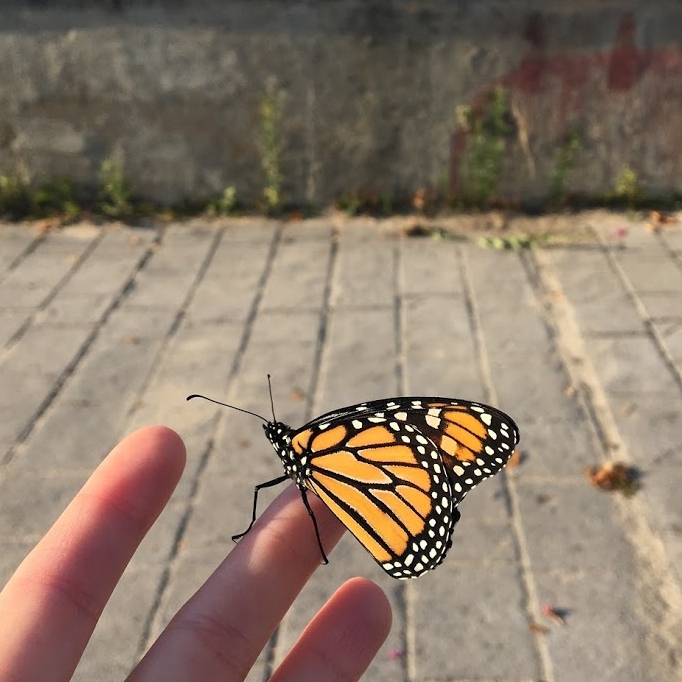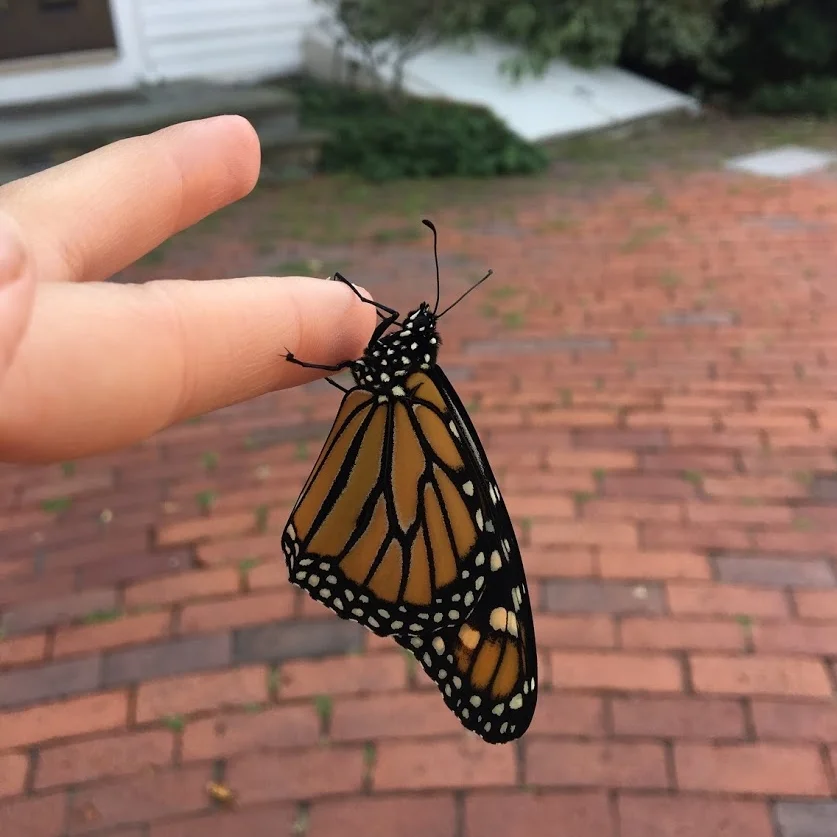From August 11 to September 2, I had the joy of raising three monarch butterflies. My friend Rachel rescued a batch of eggs from milkweed that was about to be mowed down in a cemetery in Newbury, MA. She distributed the baby caterpillars to friends and neighbors, and I adopted three of them.
Having almost no experience in raising caterpillars, I learned a lot by watching them grow, cocoon, and hatch into butterflies. If you're interested in raising monarch butterflies of your own, some of this journey might be helpful to you.
Precious Baby Caterpillars
I was shocked at how small the caterpillars were when Rachel first delivered them to me. Usually when I see monarch caterpillars in the wild (and I rarely do anyway), they're big ones. These looked tiny and vulnerable, and I was instantly concerned about their safety and wellbeing.
Thankfully, baby monarch caterpillars don't need much besides milkweed and a tank with good ventilation that they can't escape from. For three caterpillars, this Medium-Sized Reptile Carrier from Petco worked perfectly, and was under $10. Petco sells different sizes, so you may need a bigger one if you're raising more. If there are too many caterpillars in a small space, they can get territorial.
I put a paper towel at the bottom of the tank for easy cleaning. Their frass (or, ahem, poop) should be cleaned out daily.
Since these caterpillars were rescued from a cemetery, Rachel suggested that they should be named after the dearly departed. So I named mine Virginia (as in Woolf), Dorothy (as in Parker), and Shirley (as in Jackson). Virginia and Dorothy seemed to develop a close friendship, always munching together on the same leaf. Shirley was shyer and preferred to stay out of sight.
Gathering Milkweed
Keeping up with caterpillar appetites might be the hardest part of raising them. I'm lucky that I live within walking distance of a public pond that has some milkweed. Over the course of a week, I fetched fresh milkweed every other day. I cut off little stalks so the caterpillars would have the stem to climb on as well.
Milkweed is identifiable by its flat leaves and alien-like seed pods. It’s a wild plant that can usually be found by riverbanks, ponds, and cemeteries. Really anywhere wild flowers or a weed might grow.
Be sure to very carefully check milkweed before bringing it home or offering it to a monarch caterpillar. Spiders also love milkweed, and I almost took one with me one day -- aagh! More commonly, aphids (tiny yellow bugs) love milkweed and can often be found under leaves or on the stem. While aphids won't hurt the caterpillar, they'll compete for the food and just generally be a gross mess to deal with. One stalk I brought in didn't appear to have any, but suddenly, there were about ten of them. They must've hatched? I dunno. It wasn't a huge deal, but still, they’re annoying.
Molting into Big Caterpillars
Suddenly, all three caterpillars seemed to stop eating and moving! This went on for a full day, and I naturally worried that they might've gotten sick. Coming home from work one day, I found that Virginia had a crumpled, black something beside her. Oh no! I rushed to the internet and was relieved to read that Virginia had simply molted, shedding her outer layer of skin in order to grow bigger. This is normal and explains why she hadn't been moving. Caterpillars molt five times as they grow. Virginia then ate her shedded skin. Gross. The internet confirmed for me that this is normal too.
And they kept on getting bigger. Very big. Their frass gets bigger too, and I had to clean the tank more often. I gave them some sticks so they could climb to the top of the tank to form their chrysalises, but they seemed content to keep eating. I worried they were never going to transform. I'd given them too lush of a life, they had no motivation to turn into anything else.
Turns out I'm just impatient.
The first to go up was Shirley. Go Shirley! She climbed up the side of the tank and then fell (poor thing!). She resumed eating to build up more strength. Her second attempt was a success, and she started making sticky white silk to stick herself to.
Into the Chrysalis!
As soon as the caterpillars started going up to the roof, I loosened the lid of the tank a bit, just to minimize disturbing them as I continued cleaning the tank.
Once all of them had made their "J" shape hanging from the tank lid, I noticed that Shirley was looking a little... off. She was turning blackish, her antennae elongating, scrunching her body around. I thought oh no, either there's something wrong with her or....
Ahh!!! Okay, watching a monarch caterpillar turn into a chrysalis is probably one of the wildest things I've ever seen. It's like they turn themselves inside out, starting from the head. It's incredible and happens so fast. I was lucky enough to witness Shirley and Dorothy make their chrysalises. Virginia made her chrysalis last, and not under my watch. With them all cozy and secure, I cleaned out the tank, leaving sticks and fresh paper towels behind.
Then the waiting game. Monarch butterflies can take 10 - 14 days to hatch. Mine took 12-13.
Hatching
Shirley, the first to make her chrysalis, was the first to emerge. I could tell she was about to hatch when her chrysalis turned black and I could see the wings inside.
Incredible! And then one by one, they hatched! This happened over the course of a couple days. Shirley, then Dorothy, then Virginia...
Each time, the hatching happened so fast, I didn't see it. There would be a chrysalis and then, poof, a butterfly! Monarch butterflies release liquid from their chrysalis when hatching (that's the red spot behind Dorothy in the second picture). That's why it's a good idea to keep paper towels down, and sticks for them to hang from and dry their wings, though Shirley seemed content to hang from Virginia's chrysalis as she dried.
Release
Each time there was a new hatch, I was overeager to release them. I didn't want them to feel cramped or trapped! But as it turns out, butterflies can take hours to dry their wings, are fine to just hang out for a while (literally). With each new butterfly, I brought the tank outside, put my index finger in front of the butterfly for it to climb onto, and put the tank lid back on gently.
I'd wait with them as they continued to dry. They all didn't seem to want to leave. Virginia was especially reluctant, waiting for me to walk her all the way down to the pond (where I gathered her milkweed) before flying away. Each time was an awesome experience. Being up close with a butterflies like that, especially ones I took care of as caterpillars -- very cool!
Shirley, Dorothy, and Virginia all turned out to be all male butterflies. You can tell by the dots on their wings. Go figure! I like to think they all met back up again in the wild. At the very least, I hope they’re happy eating and mating and looking pretty!



